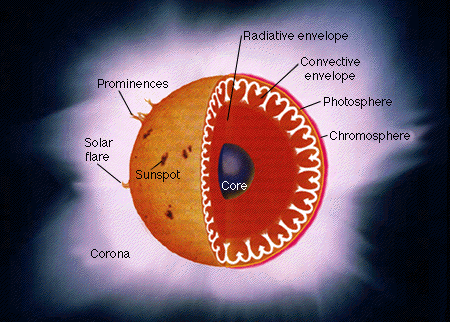The Sun (Latin: Sol), a yellow dwarf, is the star at the center of the Solar System. The Earth and other matter (including other planets, asteroids, meteoroids, comets, and dust) orbit the Sun,[9] which by itself accounts for about 98.6% of the Solar System's mass. The mean distance of the Sun from the Earth is approximately 149,600,000 kilometers, or 92,960,000 miles, and its light travels this distance in 8 minutes and 19 seconds. Energy from the Sun, in the form of sunlight, supports almost all life on Earth via photosynthesis,[10] and drives the Earth's climate and weather.
The surface of the Sun consists of hydrogen (about 74% of its mass, or 92% of its volume), helium (about 24% of mass, 7% of volume), and trace quantities of other elements, including iron, nickel, oxygen, silicon, sulfur, magnesium, carbon, neon, calcium, and chromium.[11] The Sun has a spectral class of G2V. G2 means that it has a surface temperature of approximately 5,780 K (5,500 °C) giving it a white color that often, because of atmospheric scattering, appears yellow when seen from the surface of the Earth. This is a subtractive effect, as the preferential scattering of shorter wavelength light removes enough violet and blue light, leaving a range of frequencies that is perceived by the human eye as yellow. It is this scattering of light at the blue end of the spectrum that gives the surrounding sky its color. When the Sun is low in the sky, even more light is scattered so that the Sun appears orange or even red.[12]
The Sun's spectrum contains lines of ionized and neutral metals as well as very weak hydrogen lines. The V (Roman five) in the spectral class indicates that the Sun, like most stars, is a main sequence star. This means that it generates its energy by nuclear fusion of hydrogen nuclei into helium. There are more than 100 million G2 class stars in our galaxy. Once regarded as a small and relatively insignificant star, the Sun is now known to be brighter than 85% of the stars in the galaxy, most of which are red dwarfs.[13]
The Sun orbits the center of the Milky Way galaxy at a distance of approximately 24,000 to 26,000 light years from the galactic center, moving generally in the direction of Cygnus and completing one revolution in about 225–250 million years (one Galactic year). Its orbital speed was thought to be 220±20 km/s, but a new estimate gives 251 km/s.[14] This is equivalent to about one light-year every 1,190 years, and about one AU every 7 days. These measurements of galactic distance and speed are as accurate as can be, given current knowledge, but this may change as more is learned.[15] Since our galaxy is moving with respect to the cosmic microwave background radiation (CMB) in the direction of Hydra with a speed of 550 km/s, the sun's resultant velocity with respect to the CMB is about 370 km/s in the direction of Crater or Leo.[16]
The Sun is currently traveling through the Local Interstellar Cloud in the low-density Local Bubble zone of diffuse high-temperature gas, in the inner rim of the Orion Arm of the Milky Way Galaxy, between the larger Perseus and Sagittarius arms of the galaxy. Of the 50 nearest stellar systems within 17 light-years (1.6×1014 km) from the Earth, the Sun ranks 4th[citation needed] in absolute magnitude as a fourth magnitude star (M=+4.83).
The Sun is a yellow main sequence star comprising about 99% of the total mass of the Solar System. It is a near-perfect sphere, with an oblateness estimated at about 9 millionths,[36] which means that its polar diameter differs from its equatorial diameter by only 10 km (6 mi). As the Sun exists in a plasmatic state and is not solid, it rotates faster at its equator than at its poles. This behavior is known as differential rotation. The period of this actual rotation is approximately 25 days at the equator and 35 days at the poles. However, due to our constantly changing vantage point from the Earth as it orbits the Sun, the apparent rotation of the star at its equator is about 28 days. The centrifugal effect of this slow rotation is 18 million times weaker than the surface gravity at the Sun's equator. The tidal effect of the planets is even weaker, and does not significantly affect the shape of the Sun.
The Sun does not have a definite boundary as rocky planets do, and in its outer parts the density of its gases drops approximately exponentially with increasing distance from its center. Nevertheless, it has a well-defined interior structure, described below. The Sun's radius is measured from its center to the edge of the photosphere. This is simply the layer above which the gases are too cool or too thin to radiate a significant amount of light, and is therefore the surface most readily visible to the naked eye.
The solar interior is not directly observable, and the Sun itself is opaque to electromagnetic radiation. However, just as seismology uses waves generated by earthquakes to reveal the interior structure of the Earth, the discipline of helioseismology makes use of pressure waves (infrasound) traversing the Sun's interior to measure and visualize the star's inner structure. Computer modeling of the Sun is also used as a theoretical tool to investigate its deeper layers.

-------------

-------------

-------------

-------------











